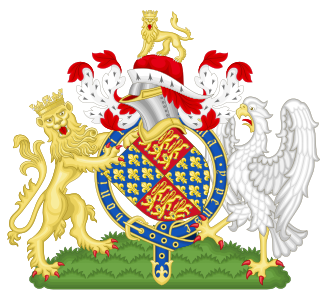
James Francis Edward Stuart, nicknamed the Old Pretender by Whigs, was the son of King James VII and II of England, Scotland and Ireland, and his second wife, Mary of Modena. He was Prince of Wales from July 1688 until, just months after his birth, his Catholic father was deposed and exiled in the Glorious Revolution of 1688. James II's Protestant elder daughter Mary II and her husband William III became co-monarchs. The Bill of Rights 1689 and Act of Settlement 1701 excluded Catholics such as James from the English and British thrones.

Under the law of the United Kingdom, high treason is the crime of disloyalty to the Crown. Offences constituting high treason include plotting the murder of the sovereign; committing adultery with the sovereign's consort, with the sovereign's eldest unmarried daughter, or with the wife of the heir to the throne; levying war against the sovereign and adhering to the sovereign's enemies, giving them aid or comfort; and attempting to undermine the lawfully established line of succession. Several other crimes have historically been categorised as high treason, including counterfeiting money and being a Catholic priest.
In English criminal law, attainder was the metaphorical "stain" or "corruption of blood" which arose from being condemned for a serious capital crime. It entailed losing not only one's life, property and hereditary titles, but typically also the right to pass them on to one's heirs. Both men and women condemned of capital crimes could be attainted.

The Treason Act 1351 is an Act of the Parliament of England which codified and curtailed the common law offence of treason. No new offences were created by the statute. It is one of the earliest English statutes still in force, although it has been very significantly amended. It was extended to Ireland in 1495 and to Scotland in 1708. The Act was passed at Westminster in the Hilary term of 1351, in the 25th year of the reign of Edward III and was entitled "A Declaration which Offences shall be adjudged Treason". It was passed to clarify precisely what was treason, as the definition under common law had been expanded rapidly by the courts until its scope was controversially wide. The Act was last used to prosecute William Joyce in 1945 for collaborating with Germany in World War II.

The Treason Act 1790 was an Act of the Parliament of the Kingdom of Great Britain which abolished burning at the stake as the penalty for women convicted of high treason, petty treason and abetting, procuring or counselling petty treason, and replaced it with drawing and hanging.
Treason Act or Treasons Act or Statute of Treasons is a stock short title used for legislation in the United Kingdom and in the Republic of Ireland on the subject of treason and related offences.

The Correspondence with James the Pretender Act 1701 was an Act of Parliament of the Parliament of England passed in 1701. The Act—the long title of which was "An Act for the Attainder of the pretended Prince of Wales of High Treason"— was a response to the Jacobite claim to the English and Scottish thrones of James Francis Edward Stuart, who declared himself King James III of England and Ireland and VIII of Scotland upon the death of his father, the exiled James II of England, in September 1701.

The Treason Act 1800 was an Act of the Parliament of the Kingdom of Great Britain. It assimilated the procedure on trials for treason and misprision of treason to the procedure on trials for murder in certain cases. It was passed as a result of an attempt on the life of George III by James Hadfield earlier that year. The Criminal Lunatics Act 1800 was passed at the same time.

The Succession to the Crown Act 1707 is an Act of Parliament of the Parliament of Great Britain. It is still partly in force in Great Britain.

The Treason Act 1766 was an Act of the Parliament of Great Britain. The long title was "An Act for altering the Oath of Abjuration and the Assurance; and for amending so much of an Act of the Seventh Year of her late Majesty Queen Anne, intituled, An Act for the Improvement of the Union of the two Kingdoms, as, after the Time therein limited, requires the Delivery of certain Lists and Copies therein mentioned to Persons indicted of High Treason, or Misprision of Treason."

The Security of the Succession, etc. Act 1701 was an Act of the Parliament of England. The Act required nearly all office-holders to take the oath of abjuration against James Francis Edward Stuart, pretender to the throne, self-styled Prince of Wales and son of the former King James II.

The Royal Assent by Commission Act 1541 was an Act of the Parliament of England, passed in 1542, which attainted Queen Catherine Howard for adultery, thereby authorising her execution. It also provided that all of Queen Catherine's assets were to be forfeited to the Crown while also creating a new method in which royal assent could be granted to legislation.

The Regency Act 1705 was an Act of Parliament of the Parliament of England.

The Correspondence with the Pretender Act 1697 was an Act of the Parliament of England which made it high treason to correspond with the deposed King James II. When James II died and his son "James III" asserted his own claim to the throne, the Correspondence with James the Pretender Act 1701 was passed to replace this provision.

The Correspondence with Enemies Act 1691 was an Act of the Parliament of England which made it high treason to correspond with the deposed King James II. It was replaced by the Correspondence with the Pretender Act 1697.

The Security of King and Government Act 1695 was an Act of the Parliament of England. Its long title was An act for the better security of his Majesty's royal person and government. It was passed in 1696 but backdated to the beginning of the parliamentary session.

The Treason Act 1714 or Trial of Rebels Act 1715 was an Act of Parliament of the Parliament of Great Britain passed during the Jacobite Rising of 1715. Its long title was "An act for the more easy and speedy trial of such persons as have levied or shall levy war against his Majesty." It enacted that anyone who was in custody for high treason before 23 January 1716 could be tried anywhere in England, regardless of where they had allegedly committed their crime. Under common law a trial normally had to take place in the county where the crime happened.

Dilston Castle is an unglazed 15th-century uninhabited tower house at Dilston in the parish of Corbridge, Northumberland, England. Both are scheduled monuments and Grade I listed buildings giving them recognition for historic and architectural value as well protection from demolition.

The Correspondence with Enemies Act 1793 was an Act of the British Parliament passed at the beginning of the French Revolutionary Wars. France had declared war on Great Britain on 1 February; the Act was passed on 7 May to prohibit trade between the countries.

The Corruption of Blood Act 1814 was an Act of the Parliament of the United Kingdom of Great Britain and Ireland which abolished corruption of blood for all crimes except high treason, petty treason and murder. Corruption of blood had until then been an automatic consequence of attainder for treason and felony. The Act was the result of the efforts of the law reformer Sir Samuel Romilly MP, who had failed to pass a similar bill in 1813.











